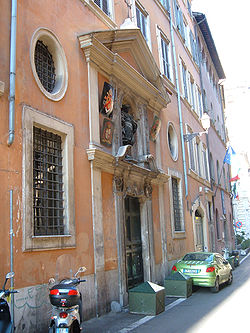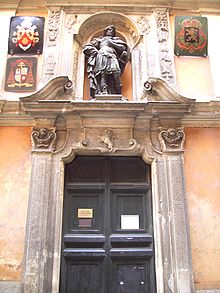- Chiesa di San Giuliano dei Fiamminghi
-
Church of St. Julian of the Flemings
San Giuliano dei Fiamminghi (Italian)
Sint-Juliaan-der-Vlamingen (Dutch)
Saint-Julien des Flamands (French)
S. Iuliani Flandrensium (Latin)Entrance of the Church of St. Julian of the Flemings, National Church in Rome of Belgium.
Basic information Location  Rome
RomeGeographic coordinates 41°53′45.2″N 12°28′33″E / 41.895889°N 12.47583°ECoordinates: 41°53′45.2″N 12°28′33″E / 41.895889°N 12.47583°E Affiliation Roman Catholic Ecclesiastical or organizational status Rectory church, titulus, National church of Belgium Leadership P. Hugo Vanermen mSC Website www.sangiuliano.org Architectural description Architect(s) Antonio Maria Borioni Architectural type Church Architectural style Baroque Direction of façade SE Completed 18th Century The Church of St. Julian of the Flemings (Italian: Chiesa di S. Giuliano dei Fiamminghi, Dutch: Sint-Juliaan-der-Vlamingen, French: Saint-Julien des Flamands, Latin: S. Iuliani Flandrensium) is a Roman Catholic church dedicated to Saint Julian the Hospitaller, located in Rome, Italy. Historically, the church has been the National Church in Rome of the Southern Netherlands and, in 1830, became the national church of the Kingdom of Belgium.
According to tradition, the church was built when Flanders converted to the Christian faith, during the pontificate of Gregory II (715–753). The little church is part of a Roman building that was once the hospice of St. Julian of the Flemings, built to shelter pilgrims from the county of Flanders (Belgium). Its official denomination since 1979 is "Royal Belgian church and Foundation of Saint Julian of the Flemings" (Dutch: Koninklijke Belgische kerk en stichting Sint-Juliaan der Vlamingen, French: Eglise et fondation royale belge Saint Julien des Flamands).
In the Consistory of November 26, 1994, Jan Pieter Schotte was appointed the first Cardinal-Deacon of St. Julian. Since his death in 2005, the titulus has been vacant until 2010.
Contents
History of the hospice and the church
Immediately after their conversion, German pilgrims started to arrive in Rome to visit the cult places of the Saint Peter and Saint Paul. Guesthouses were built to shelter and feed them: small hospices of the Saxons, the Lombards, the Frisians and the Franks (the still existing Campo Santo dei Teutonici e dei Fiamminghi[1]) were constructed around Constantine I's basilica of St. Peter's. Tradition situates the foundation of the hospice of St Julian in the 8th century, when Flanders was converted to the Christian faith during the pontificate of Pope Gregory II (715–753)[2]. In 1096, Robert II, Count of Flanders visited the hospice on his way to the Holy Land, during the First Crusade.
The first historical references to a chapel of St Julian date from the early 15th century. In this period the popes returned to Rome, after their long exile in Avignon. The return of the papal court to Rome attracted many foreigners to the city. Soon, the Netherlands created its own infrastructure to shelter the increasing number of Dutch pilgrims. From this period comes one of the oldest writings of St Julian, a copy of which is extant: the statutes and regulations of the hospice for pilgrims in 1444.
From 1624, the hospice of St Julian carefully kept records of Dutch pilgrims who visited Rome. From 1624 to 1790 21,213 were given shelter, mainly from Flanders, but also from Artois, Namur, Hainaut, Tournai and Cambrai.
Under the influence of the Renaissance popes, Rome became a center of culture, a magnet for painters, sculptors, musicians and scholars. Supported by foundations such as St Julian of the Flemings, Rome became a place of immigration for Flemings from the 15th to the 17th century. Shoemakers, carpenters, goldsmiths, tailors and soldiers found their second home in Rome. The wealthy Flemings of Rome, the high clergy, merchants, craftsmen and renowned artists became members of the board of the hospice and associate member of the Brotherhood of St Julian. This brotherhood had both a religious and a material dimension. It acquired much prestige in 1536 when the Holy Roman Emperor Charles V, born in Ghent, became a member.
Although initially the status of the foundation restricted the members of his management board to Flemings from the county of Flanders, people from other parts of the Southern Netherlands (Antwerp, Tournai, Binche ...) gradually took part to the functioning of St Julian. The directors of the hospice started to received financial support from all parts of the Netherlands. With time, the little church of St Julian became more than a center for material support and served as a meeting place for all the southern Dutch living in Rome.
In the course of the early Modern Era, the scope of the hospice widened as it became a social center and a source of financial support for the Flemings living in Rome. It promoted contacts between Flemings living in Rome. Merchants of Flemish origin acted as patrons of Flemish artists. Active in the administration of Saint Julian between 1618 and 1643, the banker Pieter de Visscher, born in Oudenaarde, had his house in Frascati decorated with frescoes by Flemish Baroque painter Cornelis Schut. Renowned artists such as Jan Miel and Louis Cousin (il Primo Luigi Gentile, Brussels) were part of the board of St. Julian. The most important patron of the foundation was Nicholas Haringhe, a pharmacist from Ypres, who donated all his fortune in the late 17th century to the hospice of St Julian. In 1695 he commissioned the current main altar painting to his friend Theodor Helmbreker.
The old organization of the foundation of St Julian disappeared when the French took control of the foundation between 1798 and 1814. The church was then officially transferred to the Kingdom of the Netherlands, and eventually to the Kingdom of Belgium.
The patrimony of the foundation consists today of three apartment buildings from the 18th to 19th centuries. The income of the foundation comes from the rent of these apartments to 35 tenants. It has currently no support of the Belgian federal government. The purpose of the foundation has remained for centuries: offer help and hospitality to pilgrims, compatriots who reside in Rome or visit the Eternal City.
Interior
The hospice was thoroughly renovated in 1681-1682. Inspired by Bernini's Sant'Andrea al Quirinale, the church got its octagonal oval shape of the early 18th century. Antonio Maria Borioni (? - 1727) designed and coordinated the construction of the new church, assisted by his brother Asdrubal Borioni. Most artworks date from the early 18th century. The central medallion of the vault depicts the apotheosis of Saint Julian the Hospitaller. The fresco was painted in 1717 by Englishman William Kent, later known as creator of the English garden and court architect.
The medallion is surrounded by four allegorical figures representing Flanders, Bruges and the Brugse Vrije[3], Ghent and Ypres. Painted in 1743 by Maximilian Dhaese, the painting over one of the side altars depicts the apostles Peter and Paul.
Exterior
The Baroque façade is decorated with a statue of St Julian the Hospitaller, located above the main entrance door. The shields of the Four Members (Bruges and the Franc of Bruges, Ghent and Ypres) also surround the medallion and adorn the facade of the church under the heading: ECCLESIA S. GIULIANI HOSPITALIS FLANDRIAE. Above the entrance of the church, a Latin inscription summarizes the history of the building until 1785.
“ TEMPLVM HOC ET XENODOCHIVM FLANDRICAE GENTIS PIETATE DIVO JULIANO ANNO SALVTIS DCCXIII DICATVM
A ROBERTO FLANDRIAE COMITE RESTITVTVM CENSVQ ADAVCTVM ANNO MXCIV SEDENTE EVGENIO IV SOLEMNI RITV CONSECRATVM
IN SPLENDIDIOREM FORMAM ANNO MDCLXXXI REDACTVM PROVISORES SOLO MARMOREO STERNI CURARVNT
ANNO DOMINI MDCCLXXXV” Cardinal-priests of St. Julian of the Flemings since 1994
- Jan Pieter Schotte (26 November 1994 - 10 January 2005)
- Vacant (2005–2010)
- Walter Brandmüller (2010-)
Notes
- ^ See Italian Wikipedia Chiesa di Santa Maria della Pietà in Camposanto dei Teutonici
- ^ http://romanchurches.wikia.com/wiki/San_Giuliano_dei_Fiamminghi
- ^ See Dutch Wikipedia Brugse Vrije
References
- Vanermen, Hugo (2004) (in Dutch), San Giuliano dei Fiamminghi - Beknopte geschiedenis van San Giuliano, http://www.sangiuliano.org/geschiedenis.html
Bibliography
- Brabandere, Jan; De Groof, Bart; Ickx, Johan (1996), 1000 Jaar San Giuliano Dei Fiamminghi, Art Books Intl Ltd, ISBN 9074377378
- Ickx, Johan (1996), "783 years "San Giuliano dei Fiamminghi"?", Archivum Historiae Pontificiae 34: 369–375, http://www.unigre.it/aph/index.htm
- Lammerant, Yolande, Les pèlerins des Pays-Bas méridionaux à Saint-Julien-des-Flamands à Rome au XVIIe et XVIIIe siècle, Pèlerins et pèlerinages dans l'Europe moderne, doi:10.1400/37009, http://digital.casalini.it/ricerca/vuota.asp?editore=EFDR&opera=00091340&progressivo=0008&pdf=2728305862_0008.pdf&tipo=A&autorizzazione=1
- Viaene, Vincent (2001), Belgium and the Holy See from Gregory XVI to Pius IX (1831-1859), Catholic Revival, Society and Politics in 19th-Century Europe, Leuven: Leuven University Press, ISBN 9058671380
Further reading
- M. Vaes, Les fondations hospitalières flamandes à Rome du XVe au XVIIIe siècle, Bulletin de l'Institut historique belge de Rome, I, 1919, p. 161-371
- Monique de Smets, Les établissements nationaux belges et français de Rome sous la Révolution et sous l'Empire (1793-1815)
- D. Bodart, Les fondations hospitalières et artistiques belges à Rome, Les fondations nationales dans la Rome pontificale, Rome, 1981, p. 61-74
- Yolande Lammerant, Les pèlerins de Tourcoing à Rome aux XVIIe et XVIIIe siècles, Nord-généalogie, 78, 1986, p. 75-81
- Yolande Lammerant, Les pèlerins de la châtellenie d'Ath à travers le "Libro dei pellegrini venuti in Roma dall'anno 1624", Annales du Cercle royal d'histoire et d'archéologie d'Ath et de la région du Musée athois, LII, 1993, p. 141-193
- B. De Groof, Natie en nationaliteit. Benamingsproblematiek in San Giuliano dei Fiamminghi te Rome (17e-18e eeuw), Bulletin de l'Institut historique belge de Rome, LVIII, 1988, p. 55-148
External links
- Official website of the Diocese of Rome, Chiesa Rettoria San Giuliano dei Fiamminghi
Categories:- National churches in Rome
- Titular churches in Rome
- Roman Catholic churches in Rome
Wikimedia Foundation. 2010.


